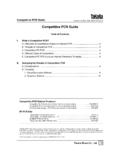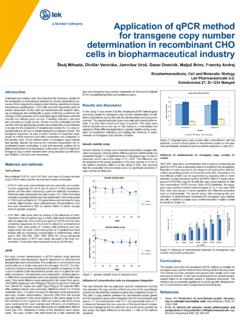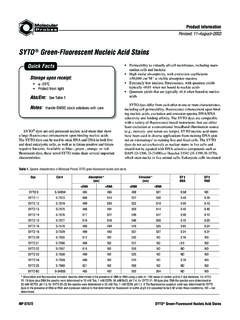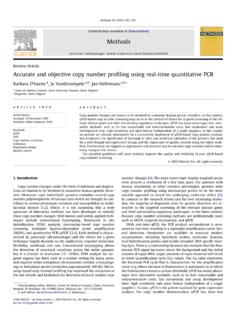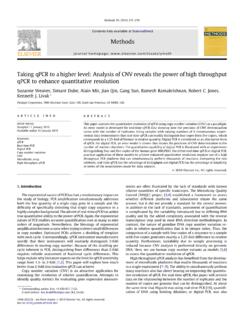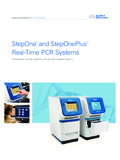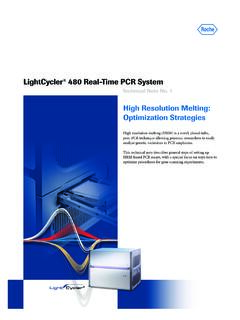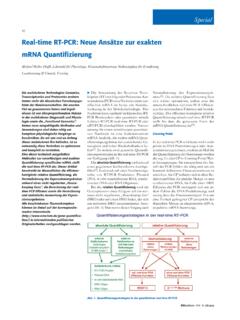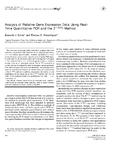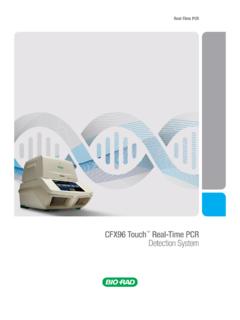Transcription of Quantification strategies in real-time PCR Michael …
1 A-Z of quantitative PCR (Editor: SA Bustin) Chapter3. Quantification strategies in real-time PCR 87 Quantification strategies in real-time PCR Michael W. Pfaffl Chaper 3 pages 87 - 112 in: A-Z of quantitative PCR (Editor: Bustin) International University Line (IUL) La Jolla, CA, USA publication year 2004 Physiology - Weihenstephan, Technical University of Munich, Center of Life and Food Science Weihenstephan, Freising, Germany Content of Chapter 3: Quantification strategies in real-time PCR Abstract 88 Introduction 88 Markers of a Successful real-time RT-PCR Assay 88 RNA Extraction 88 Reverse Transcription 90 Comparison of qRT-PCR with Classical End-Point Detection Method 91 Chemistry Developments for real-time RT-PCR 92 real-time RT-PCR Platforms 92 Quantification strategies in Kinetic RT-PCR 92 Absolute Quantification 93 Relative Quantification 95 real-time PCR Amplification Efficiency 99 Data
2 Evaluation 101 Automation of the Quantification Procedure 102 Normalization 103 Statistical Comparison 106 Conclusion 107 References 108 A-Z of quantitative PCR (Editor: SA Bustin) Chapter3. Quantification strategies in real-time PCR 88 Abstract This chapter analyzes the Quantification strategies in real-time RT-PCR and all corresponding markers of a successful real-time RT-PCR. The following aspects are describes in detail: RNA extraction, reverse transcription (RT), and general Quantification strategies absolute vs.
3 Relative Quantification , real-time PCR efficiency calculation, data evaluation, automation of Quantification , data normalization, and statistical comparison. The discussion turns into practical considerations with focus on specificity and sensitivity. Introduction Reverse transcription (RT) followed by polymerase chain reaction (PCR) represents a powerful tool for the detection and Quantification of mRNA. real-time RT-PCR (or kinetic RT-PCR) is widely and increasingly used because of its high sensitivity, good reproducibility, and wide dynamic Quantification The first practical kinetic PCR technology, the 5'-nuclease assay, was established 1993 and combines the exponential PCR amplification of a specific transcript with the monitoring of newly synthesized DNA in each performed PCR It is the most sensitive method for the detection and Quantification of gene expression levels, in particular for low abundant transcripts in tissues with low RNA concentrations, from limited tissue sample and for the elucidation of small changes in mRNA expression ,8-12 While kinetic RT-PCR has a tremendous potential for analytical and quantitative applications.
4 A comprehensive understanding of its underlying principles is important. Fidelity of real-time RT-PCR is associated with its "true" specificity, sensitivity, reproducibility, and robustness and, as a fully reliable quantitative method, it suffers from the problems inherent in RT and PCR, , amplification of unspecific products, primer-dimers, amplification efficiencies, hetero-duplex formation, This chapter analyzes the Quantification strategies in real-time RT-PCR and all corresponding markers of a successful real-time RT-PCR. Markers of a Successful real-time RT-PCR Assay RNA Extraction The integrity of purified RNA is critical to all gene expression analysis techniques. The preparation of intact cellular total RNA or pure mRNA is the first marker in gene Quantification .
5 For successful and reliable diagnostic use, real-time RT-PCR needs high-quality, DNA-free, and undegraded ,15 Accurate Quantification and quality A-Z of quantitative PCR (Editor: SA Bustin) Chapter3. Quantification strategies in real-time PCR 89 assessment30 of the starting RNA sample is particularly important for absolute Quantification methods that normalize specific mRNA expression levels against total RNA ("molecules/g total RNA" or "concentrations/g total RNA").28,29 RNA, especially long mRNA up to 10 kb,14 is easily degraded by cleavage of RNases during tissue sampling, RNA purification, and RNA storage. The source of RNA, sampling techniques (biopsy material, single cell sampling, and laser microdissection),2,16,17 as well as RNA isolation techniques (either total RNA or poly-adenylated RNA) often vary significantly between processing RNA extracted from adipose or collagen-rich tissues often has a lower yield and is of lesser quality, and contains partly degraded RNA sub-fractions (own unpublished results).
6 Particular RNA extraction techniques can work more effectively in one specific tissue type compared with another one, and result in up to 10-fold variations in total RNA RNA may contain tissue enzyme inhibitors that result in reduced RT and PCR reaction efficiencies and generate unreliable and "wrong" Quantification ,15 Most RNA preparations are contaminated with DNA and protein at very low levels. Even high-quality commercially obtained RNAs contain detectable amounts of While this is not a problem for some applications, the tremendous amplification power of kinetic PCR may result in even the smallest amount of DNA contamination to interfering with the desired "specific amplification." To confirm the absence of residual DNA either a "minus-RT" or "water control" should always be included in the experimental design.
7 It may be necessary to treat the RNA sample with commercially available RNase-free DNase, to get rid of residual DNA. However, unspecific side reactions of the DNase often result in RNA degradation (own unpublished results). It is always necessary to remove the DNase prior to any RT or PCR step. Furthermore, the design of the PCR product should incorporate at least one exon-exon splice junction to allow a product obtained from the cDNA to be distinguished on electrophoresis from genomic DNA contamination. However, processed pseudogenes ( , -actin, GAPDH or 18S rRNA) can be present and lead to confusion in data interpretation. In addition, intron-lacking pseudogenes ( -actin) with equal sequence length to endogenous mRNA have been They prevent a distinction between products originating from genomic DNA versus mRNA, which poses a significant problem in qualitative and quantitative gene Quantification .
8 Therefore, various housekeeping genes must be tested or multiplex assays of reference genes as internal controls for the assessment of RNA and cDNA quality must be A-Z of quantitative PCR (Editor: SA Bustin) Chapter3. Quantification strategies in real-time PCR 90 Reverse Transcription The second marker in quantitative RT-PCR is the production of a single-stranded (ss) complementary DNA copy (cDNA) of the RNA through the reverse transcriptase (RT) and its dynamic range, sensitivity, and specificity are prime consideration for a successful kinetic RT-PCR For many quantitative applications, MMLV H RT is the enzyme of choice,31,35,36 as its cDNA synthesis rate is up to 40-fold greater than that of AMV (own unpublished results).
9 Newly available thermostable RNAse H- RT maintains its activity up to 70 C, thus permitting increased specificity and efficiency of first primer annealing. However, this enzyme may be less robust than more conventional ones as it appears to be more sensitive to inhibitors present in RNA ,36,37 The RT step is the source of most of the variability in a kinetic RT-PCR experiment and for each enzyme the specific reaction conditions has to be optimized. Salt contamination, alcohol, phenol, and other inhibitors carried over from the RNA isolation process can affect the apparent RT ,31,34 Another source of variability is the choice of priming method used to initiate cDNA synthesis, which can be either target gene-specific or non-specific. Target gene-specific primers work well in conjunction with elevated RT-reaction temperatures to eliminate spurious ,37 The same reverse primer is used for the subsequent PCR assay in conjunction with the corresponding gene-specific sense primer (forward primer).
10 However, the use of gene-specific primers necessitates a separate RT reaction for each gene of interest. It cannot be assumed that different reactions have the same cDNA synthesis efficiency; the result can be high variability during multiple RT reactions. To circumvent these high inter-assay variations in RT, target gene unspecific primers, , random hexamer, octamer or decamer primers, can be used and a cDNA pool can be synthesized. Similarly, poly-T oligonucleotides (consisting solely of 16-25 deoxythymidine residues) can anneal to the polyadenylated 3' (poly-A) tail found on most ,30 cDNA pools synthesized with unspecific primers can be split into a number of different target-specific kinetic PCR assays. This maximizes the number of genes that can be assayed from a single cDNA pool, derived from one small RNA sample.
